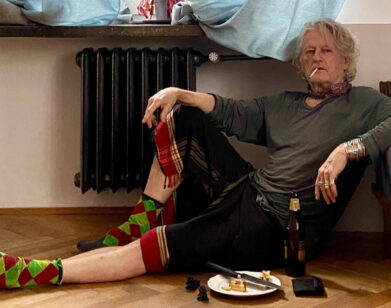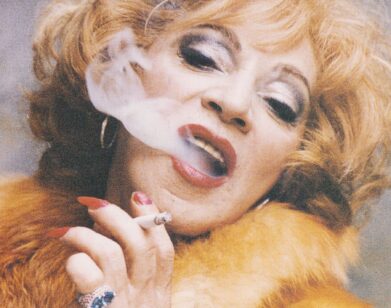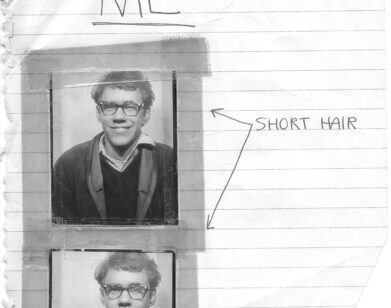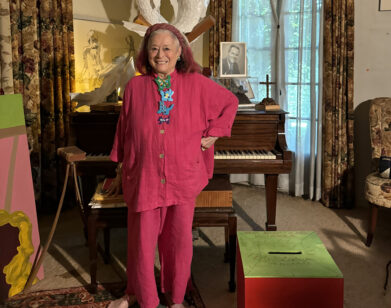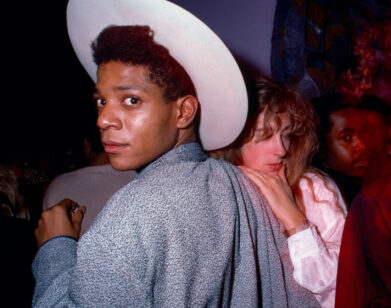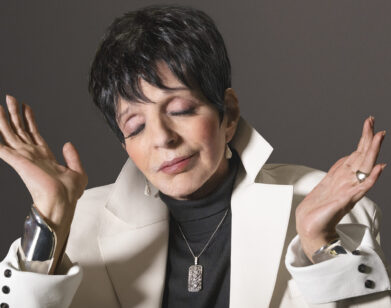art!
Kenny Scharf Talks to Trees
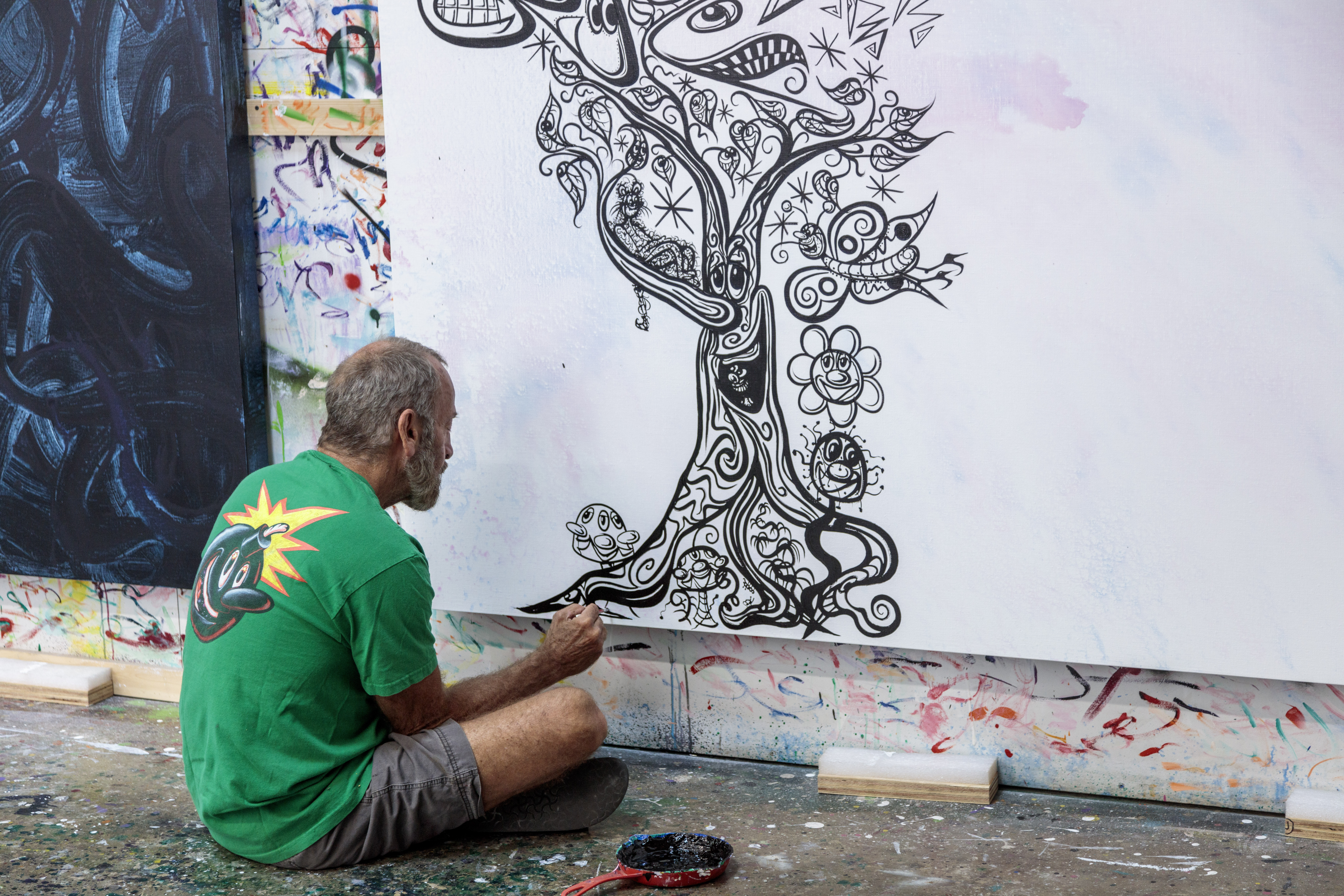
Kenny Scharf. All photography by Joshua White, courtesy of the artist and TOTAH.
There’s a tendency to think of Kenny Scharf’s paintings as direct descendants of the urban street—smart, wacky, as fast and rambunctious and in-your-face as graffiti (Scharf, in fact, has a long history with spray-paint, dating back to his early interest in graffiti art in New York City’s 1980s). Scharf is famously one of the brash feral geniuses of the early East Village art scene, a city rat dyed the florescent pink of his Southern California childhood, who ran with the of likes Keith Haring, Jean-Michael Basquiat, and the Pop god himself, Andy Warhol. With that totemic city history in mind, gallery visitors might be surprised to walk into the 63-year-old artist’s latest show at TOTAH on the Lower East and find themselves immersed not in a concrete jungle, but rather in its organic, green, carbon-depleting counterpart. “WOODZ ‘N THINGZ,” which opens on the night before Earth Day, is heavily inspired by Scharf’s lifelong love of nature. In this new suite of paintings—rendered in oil and acrylic—trees, plants, forests, planets, and molecular structures proliferate, a mad-cap Scharfian ecosystem that seems to point simultaneously toward a dizzy love of nature and the chaos of a fragile world. “This show is about Kenny’s decades-long focus on how precious planet Earth is, and how we’ve been destroying systematically,” the gallerist David Totah explains. “A deep love for trees and the forest is something we share. When all the massive fires started erupting on the West Coast, Kenny was frantic. He is also extremely upset about the destruction of the Amazon, having lived in Brazil in the ‘80s and with two half-Brazilian daughters. Kenny’s garden at his home in Los Angeles is enchanted, and he has plants everywhere in his studio.” In honor of Scharf’s new show—and for whatever hope we can still muster for our dying planet—we asked the artist a few questions about New York in the bad old days, and turning recycled flatscreen televisions into canvases.
———
INTERVIEW: The show is opening on the eve of Earth Day, and you’ve taken trees for your subject. Is there an overt environmental reading to this new body of work? What is your relationship to nature as an artist?
KENNY SCHARF: At an early age, I had beautiful recurring dreams of verdant hills and green, lush forests seemingly covered in green velvet. I would wake soothed. Dangers, not strangers. Growing up in arid Los Angeles I longed to drive to the nearby mountains, but my parents weren’t interested in nature or forests. When I became old enough to drive, I started exploring. Large trees always struck me as messengers from another time—beautiful beings, so stable and wise. Chopping them down feels like murder.
INTERVIEW: Do you think we’ll ever save our planet? Are humans doomed to self-destruction?
SCHARF: Unfortunately, we seemed doomed a long time ago. But I’ve maintained hope in order to keep myself optimistic and alive. It’s becoming harder and harder for me to remain optimistic, as I continue to witness all my fears becoming reality. I am most worried about the children.
INTERVIEW: There are so many little worlds inside your paintings. How do you start a work? Do you determine the composition before you begin or as you go?
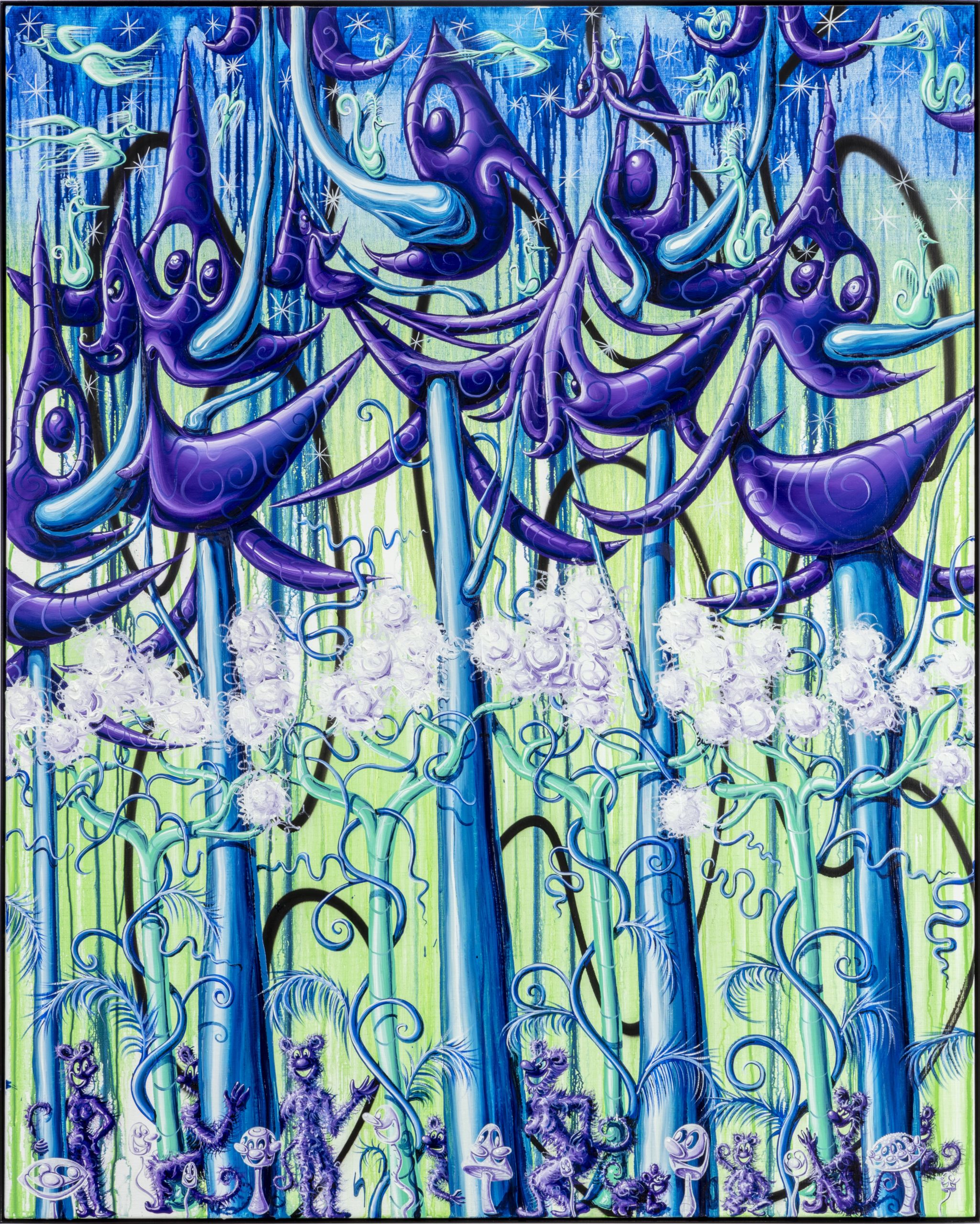
FUZZOODZ, 2022. Oil & acrylic on linen with powder coated aluminum frame.
SCHARF: The paintings in this show are completely intuitive and spontaneous. I start with an idea and see where it goes, and I never know where that will be—even if I think I do at the beginning. The process is a journey, and I want the viewer to feel a journey as well. I begin by following a mysterious path that excites, frustrates, gives joy, and challenges all in the same painting.
INTERVIEW: Coming of age in Warholian New York and showing in the East Village during its heyday, you must have seen it all. Can you tell us a crazy anecdote from the art world from that time that sums up the era?
SCHARF: Keith Haring and I shared a loft near Bryant Park on Sixth Avenue back in 1980. We would have these big parties, and one night someone was stabbed in Bryant Park. The victim saw people coming in and out of our building, and came up to our party. He was bleeding everywhere, and people thought it was an art performance until the police arrived. After that, Keith and I were kicked out of the loft.
INTERVIEW: Do you remember your first day in New York City?
SCHARF: I was taken to the cafeteria called Food in Soho, and everyone screamed “Faye Dunaway! Faye Dunaway!” I ran outside and there she was, running in a slit skirt, being filmed for the movie Eyes of Laura Mars. I had grown up in Los Angeles, the movie capital, and I’de never just randomly seen a movie star being filmed in the street. It felt so exciting.
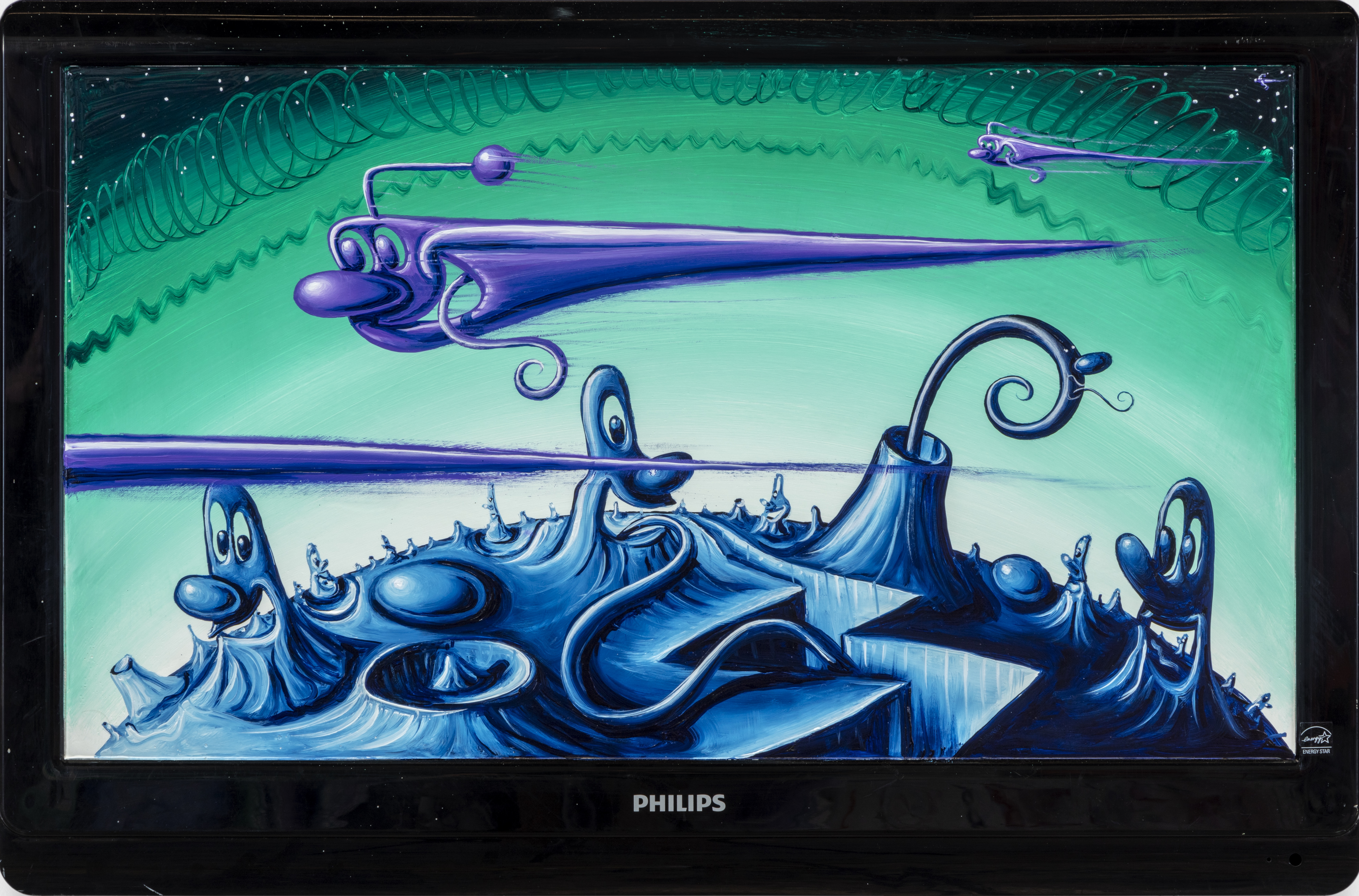
PHILIPS TIME TO GO, 2022. Oil on Philips flat screen TV.
INTERVIEW Warhol was an immensely complicated person. Some think of him as very lonely and isolated. Others think of him as the center of a social swirl. Still others consider him a ruthless person who turned his back on those in need. Those impressions might all be true. When you look back, how do you see him as a person?
SCHARF: I have heard all the stories of Andy encouraging people with bad behavior and voyeuristically enjoying their downfall. However, that was not the Andy I knew at all. He was very supportive of me as a young artist and was always there to offer advice, and I cherished and I am eternally grateful for that attention. I truly felt his artistic spirit and generosity, it was so apparent just from spending time with him.
INTERVIEW: New York and LA—they’re always in an artistic tug of war across this great country. When did you move back to California and how did it change you as an artist?
SCHARF: In the early days, I got slighted and ridiculed for my use of bright plasticky colorful cartoony visions. Hailing from L.A. wasn’t something that people admired, it was considered a place where people were airheads. I wasn’t taken seriously because L.A. wasn’t, either. When I returned to L.A., I was considered a New York interloper, and was slightly ostracized for making my name in New York. I’ve been living and painting in here for 23 years now, and finally people don’t ask me when I’m going back to New York. I feel I brought my L.A. aesthetic to New York, and brought my New York energy back to L.A.!
INTERVIEW Who are your favorite dead artists?
SCHARF: I love Hieronymus Bosch, Yves Tanguy, Henri Rousseau, Jackson Pollock, Charles Burchfield, James Rosenquist, Andy Warhol, and more.
INTERVIEW: Recently you’ve been painting on flatscreen televisions—which one might think as a black hole or final frontier compared to a painter’s canvas. What brought televisions into your works? What’s the strangest response you’ve received when showing them?
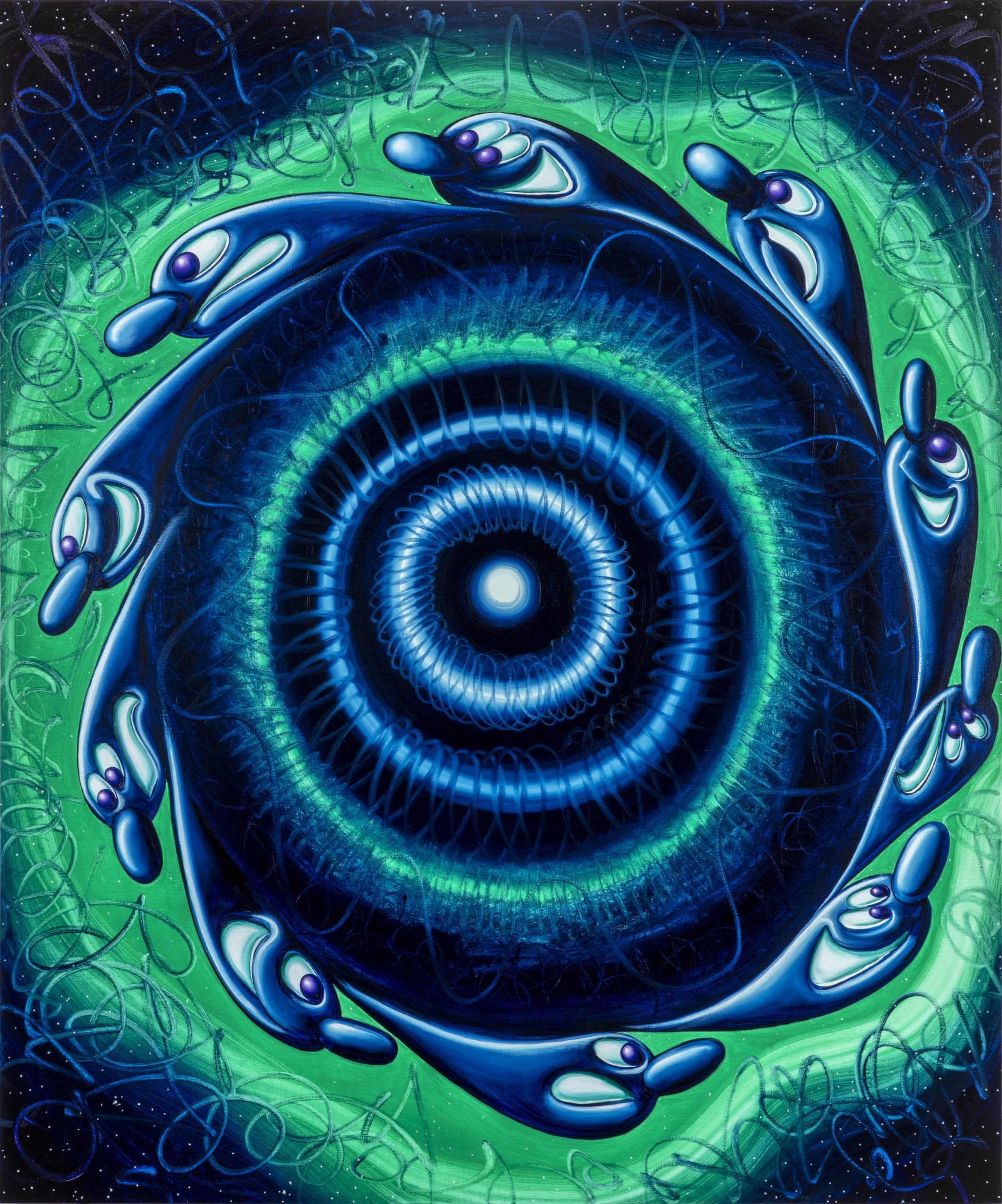
STARGET, 2022. Oil on linen with powder coated aluminum frame
SCHARF: Using televisions in their many forms is a perfect conceptual material for me. I love the idea of taking something for one thing and utilizing it for something else, and the original purpose of the object is part of the concept. Under the hypnotic spell of NBC, CBS ,and ABC, these paintings created on discarded flatscreen TVs held numerous hours of viewership by their previous owners.
INTERVIEW: Color is an important connecting thread in this new show—from reds to purples to black-and-white. How does color influence your decisions as a painter?
SCHARF: Color is, and always has been, a very important part of expression. The emotions of color and the power of their combinations can be great tools to convey the deepest feelings. So much of what I do is about emotions, and color enhances them.

